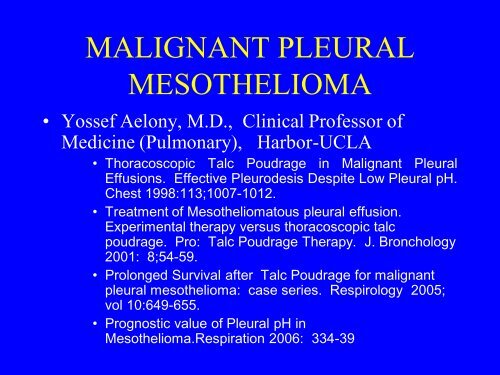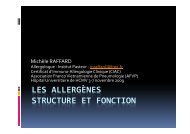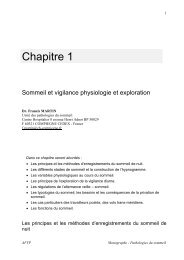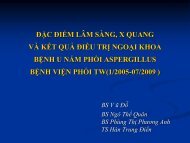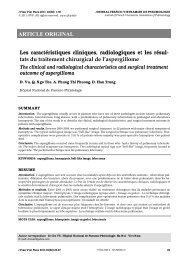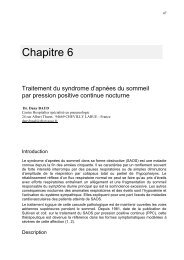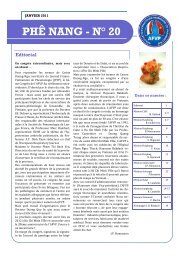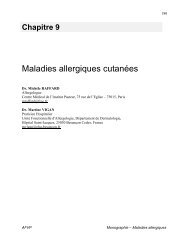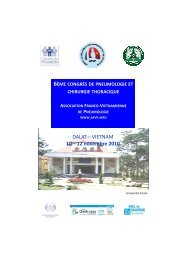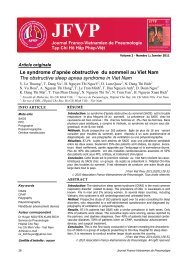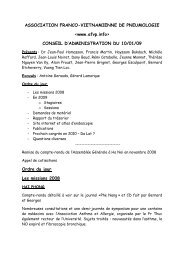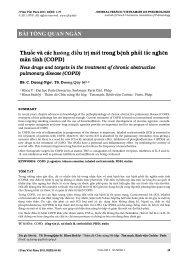MALIGNANT PLEURAL MESOTHELIOMA
MALIGNANT PLEURAL MESOTHELIOMA
MALIGNANT PLEURAL MESOTHELIOMA
You also want an ePaper? Increase the reach of your titles
YUMPU automatically turns print PDFs into web optimized ePapers that Google loves.
<strong>MALIGNANT</strong> <strong>PLEURAL</strong><br />
<strong>MESOTHELIOMA</strong><br />
• Yossef Aelony, M.D., Clinical Professor of<br />
Medicine (Pulmonary), Harbor-UCLA<br />
• Thoracoscopic Talc Poudrage in Malignant Pleural<br />
Effusions. Effective Pleurodesis Despite Low Pleural pH.<br />
Chest 1998:113;1007-1012.<br />
• Treatment of Mesotheliomatous pleural effusion.<br />
Experimental therapy versus thoracoscopic talc<br />
poudrage. Pro: Talc Poudrage Therapy. J. Bronchology<br />
2001: 8;54-59.<br />
• Prolonged Survival after Talc Poudrage for malignant<br />
pleural mesothelioma: case series. Respirology 2005;<br />
vol 10:649-655.<br />
• Prognostic value of Pleural pH in<br />
Mesothelioma.Respiration 2006: 334-39
401
702
QuickTime and a<br />
TIFF (Uncompressed) decompressor<br />
are needed to see this picture.<br />
Slide 1<br />
QuickTime and a<br />
TIFF (Uncompressed) decompressor<br />
are needed to see this picture.
1003
Qu ic k Tim e and a<br />
TI FF (Unc om p res s ed ) de c om pre s s o r<br />
are ne ede d to s e e th is p ic tu re.
1001
1101
oyd<br />
QuickTime and a<br />
TIFF (Uncompressed) decompressor<br />
are needed to see this picture.
QuickTime and a<br />
TIFF (Uncompressed) decompressor<br />
are needed to see this picture.
dejong<br />
QuickTime and a<br />
TIFF (Uncompressed) decompressor<br />
are needed to see this picture.
felix<br />
QuickTime and a<br />
TIFF (Uncompressed) decompressor<br />
are needed to see this picture.
QuickTime and a<br />
TIFF (Uncompressed) decompressor<br />
are needed to see this picture.
1102
Malignant pleural effusions<br />
(n = 206)<br />
needle biopsy fluid cytology pleuroscopy<br />
44 62 95<br />
74 96<br />
R. Loddenkemper et al. 1983<br />
97
MESO 2009 GOOD NEWS<br />
• --Rare pts live 15 yrs, w/o rx; poss occ cure<br />
• -- It may disappear by 2050<br />
• --Many drugs in testing stage<br />
• --Markers may lead to early dx.<br />
• --death rate 14.1/million 1999; 14.0 in 2005<br />
• -- BTS surgical study underway with Best<br />
Supportive Care control group<br />
• IF & gene Rx modify stage Ia disease (1%)<br />
• --Many courageous thoracic surgeons exist
Meso Bad News 2009<br />
• --Incidence expected to double in Europe &<br />
Japan<br />
• --Production of Chrysotile asbestos is at an all<br />
time high.<br />
• --Surg. Morbidity still very hi/ mortality 5-10%<br />
• -- surgical cures close to ZERO<br />
• --Most meso surgeons disdain controls (lack<br />
equipoise); so benefits of surgery=<br />
• --Iressa (EGF) failed<br />
• --Hyperthermic Cis Platin lavage is toxic<br />
• --Staging without pneumonectomy unreliable
Mesothelioma Pathology<br />
• Epithelial—Most cases & best prognosis<br />
• Sarcomatoid--worse prognosis<br />
• Mixed: intermediate;<br />
• Desmoplastic: Rare<br />
• Localized Malignant Meso: v. rare<br />
(Chest2007;131/1;295-8)<br />
• N.B. Widespread disagreement; use U.S.<br />
Canadian Mesothelioma Panel
<strong>MALIGNANT</strong> <strong>PLEURAL</strong><br />
<strong>MESOTHELIOMA</strong> Diagnosis<br />
• PATH DX MUST BE ACCOMPANIED BY<br />
APPROPRIATE CLINICAL SETTING R/O<br />
OVARIAN AND PANCREATIC CA<br />
• U.S. Canadian Mesothelioma Panel<br />
• Bx Cell type correlates with survival, but not<br />
pneumonectomy cell type.Am J Clin Path<br />
2008:130(5);754-64. So predominent cell type<br />
more important than final evaluation.
Mesothelioma Markers<br />
• EMA: Epithelial membrane antigen (no<br />
false positives)*<br />
• Mesothellin (s/s < 80% malig v benign)<br />
• Osteopontin (s/s 78/84%)<br />
• Podoplanin<br />
• Survival varies inversely with osteopontin<br />
level<br />
• *Robinson, nejm 2006; s354:3: p 306
Malignant Mesothelioma, History<br />
• Described 1770s<br />
• 100 cases in 19 th century<br />
• 1870s Onset of asbestos mining<br />
• 1920 Major escalation of asbestos mining<br />
• 1960s MM recognized as occupational<br />
• 1990s 2000-3000 cases/year in U.S.
Malignant Mesothelioma, History<br />
• 80 % now felt to be related to asbestos<br />
• Predicted peak in U.S. In 2002<br />
• Predicted peak in Europe/Japan in 2020<br />
• Epidemic proportions in Euro port cities<br />
• Environmental Disease in some villages in<br />
Capodocia & Corsica
Peto, J, et al.
Mesothelioma Pathogenesis<br />
• Thin amphibole asbestos fibers move<br />
centrifugally; indigestible.<br />
• Disease moves from parietal to visceral pleura &<br />
early to central nodes via lymphatics<br />
• Chrysotile fibers injected into rodents’ peritoneum<br />
also cause mesothelioma, but these fibers are<br />
digested & removed at human lung pH, unlike<br />
amphiboles which remain in human lung.
Mesothelioma Symptoms/Sx<br />
• Pleural Effusion—84%<br />
• Dyspnea on exertion<br />
• Chest Tightness<br />
• Chest Pain<br />
• Weight loss<br />
• Dysphagia<br />
• Dry cough<br />
• 1/3 have pleural plaques on CT contralaterally
Malignant Pleural Mesothelioma<br />
Etiology<br />
• 80+% with known heavy asbestos exposure from<br />
15-50 years prior<br />
• Heavy Irradiation<br />
• SV40 Simian Virus probably unrelated<br />
• Genetic: 5 members in one family.<br />
• Capadocia village studies (Turkey)
XRT & <strong>MESOTHELIOMA</strong><br />
• 13 cases p XRT (#2600) for Hodgkin’s Dis<br />
• 30/1 odds XRT; 45/1 XRT/chemorx<br />
• Median onset 28 yrs after XRT<br />
• 12/13 epithelial mesothelioma<br />
• 7/13 also exposed to asbestos<br />
• 10 mo. Survival; mean age 57<br />
• Indistinguishable from nonXRT mesothel.
Mesothelioma Prognosticators<br />
• EORT: Performance status, wt loss, WBC, Hb,<br />
platelets, LDH. Sex & age @ some.<br />
• Epithelial type= BETTER PROGNOSIS<br />
• Stage (no nodes, unilateral, limited to parietal<br />
pleural, small volume of disease)<br />
• Pleural pH<br />
• PET intensity (PET/CT= Benefit)<br />
• Tumor Necrosis grade on biopsy (angiogenesis)<br />
• Dynamic ContrastEnhanced MRI chest 2006:1570<br />
• Many Rxs clearly shorten life; Does any Rx<br />
extend life in average pt or individuals
Pleural pH in MPE<br />
• Mixed results as to whether low Pleural pH<br />
correlates with shorter survivalin MPE<br />
• Unequivocal data that tetracycline is INeffective<br />
in low Pleural pH effusions<br />
• Thoracoscopic talc poudrage was Effective in<br />
58%# & 8/10* with Pleural pH< 7.20<br />
• #Sanchez-Armengol Chest 1993<br />
• *Aelony Chest 1998:113;1007-1012.
201
Mesothelioma Staging (Buchart)<br />
I limited to pleura, lung, pericardium<br />
II limited to thoracic contents: invasion of mediastinum,<br />
chest wall, contralateral pleura<br />
chest nodes only<br />
III includes direct invasion outside the thorax<br />
(diaphragm,peritoneum)<br />
extrathoracic nodes<br />
IV distant bloodborne metastases
Mesothelioma Survival by Stage<br />
of Disease (Butchart)
Original surgical staging of MM<br />
• Presumed analogous to lung cancer.<br />
• Confidence in xrays, CT, MRI, PET<br />
cervical mediastinoscopy to define extent.<br />
• But pneumonectomy failed to cure early<br />
stage disease due to failure of staging:<br />
micrometastases early in disease.<br />
• 7 schemas of surgical staging over the yrs
STAGING of Mesothelioma<br />
• 1. CT (Automated thickness on CT (Acad<br />
Radiol, 2005 Oct; 12(10):1301-9)<br />
• 2. SURGICAL staging requires<br />
PNEUMONECTOMY<br />
– N2 nodes are unfavorable<br />
– IMIG system (1996)=TNM; some favor this<br />
– BRIGHAM sometimes predictive; based in free<br />
surgical margins with pneumonectomy & an estimate<br />
of < 1 cc residual tumor postop
Survival epi v sarc
Meso with N2 Nodes
<strong>MESOTHELIOMA</strong> STAGING<br />
• BOUTIN (& IMIG) TNM<br />
• Ia: Parietal Pleura only<br />
• Ib: Visceral Pleura also in ‘scattered foci’<br />
• I-III Technically resectable<br />
• IV: Technically unresectable
True Surgical Staging of Mesos*<br />
• Cervical Mediastinoscopy (16% false neg CT),<br />
laparoscopy (6%), perit. Lavage (3%).: 14% upstaged.<br />
• Mediastinoscopy + in only of 1/3 of N2/N3 nodes at<br />
thoracotomy<br />
• Some surgeons assume N2 nodes c/w resection but<br />
evidence points to N2 indicating distant spread<br />
• *Rice et al. Extended surgical staging for potentially<br />
resectable malignant pleural mesothlioma. Ann Thorac<br />
Surg 2005;80: 1988-93.
PET STAGING IN<br />
<strong>MESOTHELIOMA</strong><br />
• T4: 19% SENS (Flores et al 2005)<br />
• Mediastinal nodes: 11% sens<br />
• Sens for gross distant disease (24%)<br />
• 11/29 (38%) ‘resectible’ Mesos by CT found to be<br />
Unresectible by CT/PET<br />
(Erasmus; J Thorac Cardiovasc Surg<br />
2005;129:1364-1370).
Untreated Mesothelioma<br />
• Law,Gregor,Hodson,Bloom,Turner-Warwick:<br />
Thorax 1984;39:255-59<br />
• 64 patients in good general condition whose GP<br />
vetoed surgical/XRT/chemo Rx: mean survival<br />
18 months from onset of SX<br />
• 5/64 (8%) survive >5yrs; 1 survived 16 yrs!<br />
• Concl: although 6-12 mo mean survival reported,<br />
a portion of patients live for many years.
Mesothelioma Rx CHOICES<br />
• Best supportive care<br />
• Pleurodesis (Thoracoscopic talc poudrage)<br />
• Catheter drainage w or w/o Pleurx Catheter<br />
• Par. Pleurectomy with visceral decortication<br />
• Extrapleural pneumonectomy (EPP)<br />
• Multimodality surgery/XRT/chemotherapy<br />
• Intensity Modulated XRT<br />
• ImmunoRx/Gene Rx/Hyperthermal chemolavage
502
WHAT IS THORACOSCOPIC<br />
TALC POUDRAGE (TTP)<br />
• THORACOSCOPY FREES UP THE LUNG,<br />
EXPOSING MOST <strong>PLEURAL</strong> SURFACES FOR<br />
EVENTUAL TALCAGE<br />
• OBSERVATION PERMITS SOME DIRECT<br />
STAGING WITH BIOPSY<br />
• TALC IS APPLIED DIRECTLY TO THE<br />
<strong>PLEURAL</strong> SURFACES TO ENHANCE<br />
PLEURODESIS<br />
• Medical thoracoscopy/Pleuroscopy is NOT VATS
QuickTime and a<br />
TIFF (Uncompressed) decompressor<br />
are needed to see this picture.
1104
1202
702
1304
1303
RESULTS Of TTP*<br />
• PALLIATION OF DYSPNEA--100%<br />
• SURVIVAL 24 +/- 13 MONTHS FROM TTP.<br />
• MEDIAN 19.4 MONTHS<br />
• SURVIVAL 26+ MONTHS FROM ONSET OF<br />
SYMPTOMS<br />
• * Prolonged Survival after Talc Poudrage for<br />
malignant pleural mesothelioma: case series.<br />
Respirology 2005; vol 10:649-655.
Patient outcomes after TTP for Malignant<br />
Mesothelioma (N=26)<br />
• Chest Tube Drainage 2.8 +/- 1.4 days<br />
• Hospital Stay (mean) 3.9 +/- 2.7 days<br />
• Hospital Stay (median) 3.0 days<br />
• Palliation of Dyspnea 26 (100%)<br />
• Late recurr. of Effusion (p mean 17 mos: 19%)<br />
• Significant persistence of fluid: 0<br />
• Fever & pain may occur, easily controlled
<strong>MESOTHELIOMA</strong> & TALC<br />
PLEURODESIS<br />
QUALITY OF LIFE<br />
• NO MORTALITY<br />
• MOST PAIN & DISCOMFORT IN LAST<br />
1-3 MONTHS OF LIFE<br />
• WEIGHT LOSS MORE PROMINENT<br />
THAN PAIN
Biological effects of talc*<br />
• Most effective sclerosant; does pleurodesis<br />
prolong life Does improve QOL<br />
• Promotes cell death in vitro<br />
• talc alters the angiogenic balance in the<br />
pleural space from a biologically active &<br />
angiogenic environment to an angiostatic<br />
milieu (Eur Respir J 2007; 29: 761–769)<br />
• *V. Anthony & collaborators
Prophylactic Irradiation of entry<br />
sites<br />
• Boutin: 40% outgrowths from<br />
thoracoscopy sites; zero outgrowths with<br />
low dose prophylactic irradiation to sites<br />
• Aelony et al (unpublished):<br />
– 1/40 with symptomatic outgrowth from<br />
thoracoscopy site<br />
– 1/40 with outgrowth from thoracentesis site<br />
– Both pts responded well to ‘late’ XRT
PLEURX CATHETER*<br />
OPD/ DAY SURGERY; home catheter care<br />
• 40-60% PLEURODESE W. CATHETER<br />
• PLEURODESED PTS LIVE 3.6 X LONGER<br />
(254 DAYS VS 71 D) Does pleurodesis improve<br />
survival<br />
• GREAT LOSS OF PROTEIN/LYMPHOCYTES<br />
• COST KP $2500 FOR MATERIALS<br />
• *Tremblay & Michaud 250 Pleurx catheters/MPE<br />
Chest 2006; 129:362-362.
Mesothelioma Rx<br />
• Pisani et al Mayo Clin Proc 1988<br />
– NO TREATMENT AFFECTED SURVIVAL<br />
– Chahinian 1982:<br />
– Surgery never curative<br />
– XRT ineffective<br />
– Doxorubicin disappointing (12.5 mos survival)
<strong>MESOTHELIOMA</strong>: SURGICAL<br />
STUDIES<br />
• Demonstrate High Technical Skill<br />
• 4- 11 % Perioperative Mortality (often<br />
omitted in Kaplan-Meier Curves)<br />
• Highly Selected Patients (denominator)<br />
• Historical Controls<br />
• van Ruth; Chest 2003;123:551-561<br />
contemporary review of surgical Rx MPM.
Surgical rx of Malignant Pleural<br />
Mesothelioma<br />
• Sugarbaker et al J. CVThor Surg 1/99<br />
• Selected patients: 1 of 3-4 referrals<br />
• Trimodality Rx: 183 patients<br />
• 3.8 % perioperative mortality<br />
• 50% morbidity<br />
• median survival 19 months<br />
– epithelial grp: 26 mos
Surgical Rx of Malignant Pleural<br />
Mesothelioma<br />
• Sugarbaker et al JThorCVSurg 1/99<br />
• Both types Epithelial Fibrosarcomatoid<br />
• 2 yrs: 38% alive 52% 16%<br />
• 5 yrs 50%# 21%* 0<br />
• # 7 / 14 pt with his stage 1 disease (of 7-800)=1%<br />
• * 21% of the few pts who were followed 5 yrs
Trimodality Therapy—Risks 1<br />
• Consider: does patient accept major pain,<br />
thoracotomy scar, 4-11% immediate mortality,<br />
50% complication rate, prolonged hospitalization<br />
from an experimental technic with no cures yet.<br />
• Best supportive care should NOT be painful, is<br />
inexpensive & non-invasive<br />
• Each patient needs to decide which approach is<br />
more to his preference.<br />
• Which is more humane
Trimodality Therapy—Risks 2<br />
• Recent prospective study from the most active<br />
surgical group (Sugarbaker,Boston)<br />
• 60 pts with bicavitary hyperthermic cisplatin<br />
lavage after pleurectomy<br />
• 11% immed. mortality; median surv. 10.5mos<br />
• 32% atrial fibrillation<br />
• ‘Hi rate’ of diaphragmatic patch failure,<br />
DVT, PE<br />
Rate of suicide, late surgical death, QOL=
Hyperthermic Cisplatin 2009<br />
Zellos et al (Sugarbaker)<br />
• Phase I study extrapleural pneumonectomy &<br />
intracavitary intraoperative hyperthermic cisplatin<br />
J Thorac Cardiovasc Surg 2009 137(2) 453-8<br />
• dosing was randomized N=42 (18 stage1-2)<br />
• hi dose median surv. 26 mos<br />
• lo dose med surv 16 mos<br />
– But p= 0.35 NS!<br />
• LOS 15 days<br />
• (p=0.35)
Trimodality Rx of MM<br />
• Baldini Ann Thor Surg 1997;63:334-338<br />
• Extrapleural pneumonectomy + postop<br />
CAC chemotherapy + XRT<br />
• Recurrences were<br />
– 67% local<br />
– 50% abdominal<br />
– 33% contralateral thorax<br />
– 17% distant
Surgical Morbidity in MPM<br />
• Mortality 30% in 1980s, now 5-10%<br />
• Byrne et al Chest 2002;122;2256-9; 5% of left<br />
pneumonectomies require a 2nd thoracotomy<br />
with pericardiectomy due to constrctive<br />
pericarditis by the Visceral pericardium<br />
• < 10% reoperate for ruptured diaphragm<br />
• LOS 11 d median; 31% complix 3+<br />
• Lifetime hospital days not reported
Surgical Math<br />
• 183 patients; 176 perioperative survival<br />
• 50% 5 year survival w ‘Brigham’ early<br />
stage epithelial meso disease=7/14<br />
• Mean followup 13 months<br />
• Perioperative mortalities (4%) not included<br />
• Actual 5 year survival 7/700 = 1% in 1998<br />
• Actual 5 year survival by 2009 = <br />
• (Sugarbaker et al J. CVThor Surg 1/99)
Mesothelioma<br />
Survival by<br />
Selection<br />
• Sugarbaker: 50% 5 year survival stage I<br />
• Rusch J. Thorac CV Surg 2001:122;788-95<br />
(Surg/XRT) : 19 early stage; median survival 34<br />
mo. after EPP (pneumonectomy) 8% mortality<br />
• Boutin: median 33 mo. survival p talc poudrage,<br />
thoracoscopic Stage Ia. No mortality<br />
• 6-12 mos survival only applies to all comers<br />
without selection or staging
Missing Data in Surgical Series<br />
of MPM<br />
• Rusch et al. J. Thorac CV Surg<br />
2001:122;788-95 (Surg/XRT)<br />
• # of pts refused entry into study<br />
• Survival data on refused pts<br />
• Total surgical deaths; suicides<br />
• Life Hosp. days for Treated & Non-Rx pts
TMT in MPM 2009 Hasani J<br />
Thorac Oncol (2004-08)<br />
• Preop staging: bilat VATS;mediast. Lap.<br />
• T1-3 N0-1 M0; all ‘operable after PET-CT’<br />
• 1/3 non epithelioid<br />
• EPP: 18 pts qualified: 20 month median survival<br />
• half pts did not qualify for EPP: also 20 mo surv.<br />
• Retrospective but closest to controlled study so far
Mesothelioma Rx Pemetrexed<br />
• Pemetrexed +/- Cisplatin* (N=450)<br />
– 41% vs 17% tumor shrinkage<br />
– High toxicity, reversed with B12 & Folate<br />
– Dexamethasone to prevent rash<br />
– 12 Months survival vs 9 months<br />
– Small difference for SOB,pain,,QOL,cough<br />
– QOL WORSE 1st 3 mos c both Rx; no nontreated<br />
controls<br />
– Championed as standard of care by investigators<br />
– *Vogelzang et al. JCO 2003;21:2636-44.
Pemetrexed v. Best support. care<br />
• Pts who had prior chemorx with other rx<br />
• N- 243<br />
• Median survival 9.7 mos with BSC alone<br />
• Median survival 8.4 mos with Pemetrexed<br />
• P=0.74<br />
• No difference in QOL scores.
Chemorx: cisplatin<br />
• 20% response rate<br />
• No survival benefit in RCT of MVC*<br />
• Rx was tolerated well by pts, median 65 yrs<br />
• Chest pain decreased during rx, but not 6 mos later<br />
• *Muers et all. Active symptom control with or<br />
without chemorx mitomycin,vinblastin, cp Lancet<br />
2008: 371(9625): 1685-1694 (n=403 stage 3&4)
Mesothelioma CT Scan: Pre-<br />
Post Tomudex/Cisplatin
Naltitrexed/cisplatin<br />
• 229 ‘unresectible’ Mo patients<br />
• HRQOL study<br />
• Survival 8.8 v 11.4 mos w 2 drugs (2.6 mos)<br />
• 15% N & V incr w q cycle<br />
• No pain benefit; progressive fatigue<br />
• Main palliation= dyspnea (only 21% had talc<br />
poudrage)<br />
• No non-chemo QOL control<br />
• Bottomley JCO Mar 20 2006:<br />
1435–1442
Mesothelioma Chemorx *<br />
• 1998-2003 chemo rx without pemetrexed<br />
• Pleurodesis first<br />
• ‘Nonsurgical patients’ Randomized<br />
• to Early or Delayed chemorx MVP<br />
• Delayed rx given at time of significant<br />
progression<br />
• 14 v 10 months median survival (NS)<br />
• *O’Brien et al:Annals of Oncology 2006<br />
17(2):270-275
Carboplatin,Dox,Gemcitabine<br />
Hillardal 2008 J thor onc<br />
• 173 <strong>MESOTHELIOMA</strong> pts in Scandinavia<br />
• NO SURGERY (2000-2007)<br />
• 1/3 WITH PLEURODESIS FIRST<br />
• 17 MO. MEDIAN SURVIVAL (EPITH)<br />
• 22 MO MED SURVIVAL With GOOD PS,<br />
EARLY STAGE<br />
• QOL sounds good
XRT IN <strong>MESOTHELIOMA</strong><br />
• Very effective for local soft tissue control,<br />
prophylactically or when outgrowth occurs<br />
• Ineffective for total thorax control<br />
• Intensity Modulated XRT (MD Anderson)*<br />
• Only 5% recurred in XRT field<br />
• 14 mos median survival for EPP with curative<br />
intent + 35 Gy after 2.5 mos<br />
• *Ann thorac Surg 2007; 84(5): 1685-92; rice et al
Conclusion#1: Mesothelioma in<br />
2009<br />
•<br />
1. If QOL is main goal w large Pl effusion: Talc.<br />
a. Assures dx & provides long term relief of SOB.<br />
b. Survival benefit unproven.<br />
2. If no effusion, little data available on Rx.<br />
3. If Mixed or sarcomatoid Mesothelioma,<br />
prognosis is worse & little hope to help patients<br />
by an intervention beyond pleurodesis. Seek new<br />
agents.<br />
4. If early disease, consider a randomized study.
1. Ia disease with nodules < 5 mm or nonspecific<br />
findings: consider for immunotherapy.<br />
2. Stage Ia patients who want to go for broke after<br />
informed consent might consider SK, M.D.<br />
Anderson, Boston, U Penn programs or a local<br />
approach of combined therapy. Cost exceeds<br />
$100,000 in the first year. (cf $4000 TTP) No<br />
known cures/no known survival benefit. We<br />
should favor prospective controlled studies.<br />
3. Stage =>Ib there is no evidence that the pain vs<br />
benefit equation favors therapy.<br />
•<br />
Conclusion #2: Mesothelioma in<br />
2009
Conclusion #3: Mesothelioma in<br />
2009<br />
1. Patients wishing low pain trials locally could be<br />
tried on chemorx du jour, ideally in a controlled<br />
program.<br />
2. No one should be denied pain meds sufficient to<br />
palliate this disease.<br />
3. Every patient deserves a caring doctor for the<br />
duration of his treatment.<br />
4. Dr. Cameron at UCLA is willing to do<br />
pleurectomies, but…………….
QuickTime and a<br />
TIFF (Uncompressed) decompressor<br />
are needed to see this picture.
<strong>MESOTHELIOMA</strong> STAGE (IMIG)<br />
Ia: Parietal pleura only<br />
Ib: Scattered Visceral pleural foci<br />
II: Confluent Visceral pleural tumor<br />
may include invasion of diaph/lung<br />
III: N1 or N2 nodes or invasion of non- transmural pericardium,<br />
endothoracic fascia, or mediastinal fat *<br />
IV: Technically<br />
unresectable due to extension, to distant mets, or N3 disease<br />
*At the time this scheme was developed it was not yet known that<br />
CT, mediastinoscopy, MRI, PET were all insensitive at picking up<br />
Malignant N2/N3 nodes.
QuickTime and a<br />
TIFF (Uncompressed) decompressor<br />
are needed to see this picture.
Sarcomatoid Mesothelioma<br />
QuickTime and a<br />
TIFF (Uncompressed) decompressor<br />
are needed to see this picture.
QuickTime and a<br />
TIFF (Uncompressed) decompressor<br />
are needed to see this picture.
pH & Survival mechanism<br />
• Glucose entry block (IV glucose: no<br />
change)<br />
• H+ & lactic acid exit block<br />
• Failure of augmented FI02 &<br />
hyperventilation to change pleural gases<br />
• Increased acid production due to<br />
metabolism of pleural cells
Meso Survival by ECOG<br />
Performance Status
QuickTime and a<br />
TI FF (Uncompressed) decompressor<br />
are needed to see this pict ure.
801
<strong>MESOTHELIOMA</strong> DATA<br />
• 26 CONSECUTIVE PATIENTS/23 MALE<br />
• 88% EPITHELIAL;12% SARCOMATOUS<br />
• MEAN/MEDIAN AGE: 68YRS; 3 < 60<br />
• ALL WITH LARGE EFFUSIONS<br />
• PRIMARY CARE CENTER: 64% LOCAL<br />
36% REFERRED<br />
• NO CONSCIOUS SELECTION PROCESS
Carboplatin + Pemetrexed<br />
• Tolerance study, ‘inoperable’ pts<br />
• 12.7 median survival<br />
• Cf 13 mos with Cisplatin/Pemetrexed<br />
• No control but Carboplatin usually better<br />
tolerated than cisplatin
Mesothelioma 2006, Clinical<br />
Research<br />
• Intrapleural (IP) Interleukin II & G-<br />
Interferon (Marseille)<br />
• IP hyperthermal Cisplatin lavage<br />
• IP Gene Therapy: Sterman,<br />
Albelde,Kaiser; U of Pennsylvania<br />
• Intraoperative Photodynamic therapy
Hyperthermic chemotherapy<br />
• Dal Yoo et al, Washington, DC<br />
• 60 patients with peritoneal mesothelioma<br />
• Laparoscopic rx with heated intraperitoneal cisplatinum,<br />
doxorubicin & postop IP paclitaxel.<br />
• Median survival 55 months (cf 6 months)<br />
• 1/3 with asbestos exposure. Is this the same<br />
disease<br />
• (Paul Sugarbaker)
Hyperthermal cisPlatin in Pleural<br />
mesothelioma<br />
• Brigham phase I & II tolerance study<br />
• 44 ‘resectible’ with pleurectomy/decort+<br />
• 1 hr lavage cisplatin @ 42 degrees C.<br />
• Survival 9 mo. 13 mo. if resected;<br />
– 6 mos with low dose;<br />
– 18 mos with hi dose (p=0.02)<br />
– Epithelial meso w hi dose: 26 mos<br />
• Concl: hi dose more effective than low dose<br />
• Richards et al JCO 2006;24/1561-<br />
67.(David Sugarbaker)
Hyperthermal cisPlatin in Pleural<br />
• M & M<br />
mesothelioma<br />
• 11% 30 d mortality (+at least 2% later)<br />
• 57% renal failure<br />
• 25% 3+ grade toxicity + 31% Atr. Fib<br />
• At least 2 repeat thoracotomies<br />
• QOL, LOS,M & M & survival all much worse<br />
than talc poudrage (uncontrolled)<br />
• Richards et al JCO 2006;24/1561-
QuickTime and a<br />
TIFF (Uncompressed) decompressor<br />
are needed to see this picture.
Downside of pleurodesis<br />
• Prevents subsequent intrapleural<br />
experimental therapies; gene rx, immunorx,<br />
& Intrapleural chemorx.<br />
• ARDS No cases in our 40 mesotheliomas<br />
& Boutin’s 188+ cases<br />
• Despite palliation of SOB, no proof that<br />
early control of effusion affects survival
Mesothelioma—a look from<br />
2007 to the future<br />
• Mesothellin may pan out as an early marker<br />
• TGF-beta may slow tumor growth<br />
• Gadolinium/MRI may improve staging<br />
• Intensity modulated radiation Rx (Stevens, MD<br />
Anderson). Unpublished 62% NED at 2 yrs<br />
• Staging with total body burdan of disease<br />
• Unknown result of Chrysotile use worldwide
Mesothelioma 2007—what<br />
physicians should do<br />
1. Reviewers should insist that all data be presented.<br />
2. Read critically & maintain healthy skepticism for<br />
all studies that do not have a pleurodesis or ‘best<br />
supportive care(BSC)’ control.<br />
3. Seek processes that maximize outpatient treatment<br />
rather than requiring the rest of the patient’s life<br />
be spent in hospital & ECF.<br />
4. Think Hospice from the beginning.
Mesothelioma; characteristics of<br />
our diagnostic/treatment center<br />
• Kaiser-Permanente Hospital/Clinic HMO<br />
• Not a tertiary referral center<br />
• Pleural effusion referred early to pulmonary<br />
• 64% of patients from Harbor City Area<br />
• 36% referred from other Kaiser Centers for<br />
– diagnosis in 28%<br />
– pleurodesis alone in 8%
403
Ipl Interleukin-2 Phase II Study<br />
in Pleural Mesothelioma<br />
Astoul, et al., Cancer, 1998
Lovastatin and Mesothelioma
THORACOSCOPY IN MPE<br />
• 1. Idiopathic effusion: for diagnosis. Consider<br />
Talc poudrage at same event.<br />
• 2. Known lung cancer with negative cytology:<br />
rule in mets*; Talc<br />
• 3. Positive pleural cytology : talc.<br />
• 4. Ca lung/no effusion: consider Thorscoscopy<br />
• *Decker et al Chest 1978;74:640: 4/75 lung ca<br />
with pleural effusion were resectible.
THORACOSCOPIC TALC<br />
POUDRAGE VS SLURRY<br />
• DAYS OF DRAINAGE/HOSPITAL<br />
• ABILITY TO FREE UP THE LUNG<br />
• DEGREE OF <strong>PLEURAL</strong> EXPOSURE<br />
• TALC IN EFFLUENT<br />
• NO CONTROLLED DATA IN<br />
<strong>MESOTHELIOMA</strong>
Overall Survival: IPL IL-2 in<br />
MPM<br />
Astoul, et al., Cancer, 1998
Table III <strong>MESOTHELIOMA</strong> SURVIVAL @ KAISER<br />
PERMANENTE<br />
SERIES N MOS DX THORA- RESECTION CHEMO- CHEST<br />
to DEATH COTOMY THERAPY PAIN<br />
A-KP 92 7.8 16 (17% 7 (8%)<br />
B -KP 47 8.7 +/- 6.5 22 (47%) 8 (17%) 13 (28%) 14(30%)<br />
C -(TTP) 26 21.9 +/- .....* 0 0 5 (19%) 11(42%)<br />
*p < .001 comparing C & B
Prophylactic Irradiation of entry<br />
sites<br />
• Boutin: 40% outgrowths from<br />
thoracoscopy sites; zero outgrowths with<br />
low dose prophylactic irradiation to sites<br />
• Aelony et al (unpublished):<br />
– 1/40 with symptomatic outgrowth from<br />
thoracoscopy site<br />
– 1/40 with outgrowth from thoracentesis site<br />
– Both pts responded well to ‘late’ XRT
<strong>MESOTHELIOMA</strong> RX TODAY<br />
IN VIET NAM<br />
• 1. Determine Dx for sure with thoracoscopic<br />
biopsy & expert pathological review.<br />
• 2. Control Pleural Effusion with thoracoscopic<br />
talc poudrage.<br />
• 3. Control pain with narcotics.<br />
• 4. Consider Pemetrexed chemotherapy, balancing<br />
side effects with 3 month increased survival<br />
• 5. With rare IA Epithelial Mesothelioma (parietal<br />
pleura only), consider referral to a research ctr.<br />
• 6. Remember: no surgical cures as yet!
1102
904
903
803
902
604
701
804
404
THORACOSCOPIC<br />
PROCEDURE<br />
• THORACENTESIS & ENTRAIN AIR<br />
• LOCAL ANESTHESIA; 1 PUNCTURE<br />
• 7 mm SCOPES VIA TROCAR<br />
• LOOK, LYSE, BIOPSY<br />
• INSUFFLATE TALC<br />
• CHEST TUBE DRAINAGE
Perioperative mortality, no. 0<br />
Perioperative morbidity:<br />
Prolonged hospitalization (14 days), no. (%) 1 (4)<br />
Suture cellulitis, no. (%) 4 (15)<br />
Survival from onset of symptoms, mo:<br />
Mean + SD 28.0 16.6<br />
Median (range) 23.5 (3.9-75)<br />
Survival after TTP, mo:<br />
Mean + SD 23.8 16.3<br />
Median (range) 19.4 (2.9-68)
Table 2. Clinical outcome after TTP for malignant mesothelioma in 26 patients.<br />
Duration of chest tube drainage, days (SD)<br />
2.8 1.4<br />
Hospital stay, days (SD) 3.9 2.7<br />
Median hospital stay, days (range) 3.0 (1-14)<br />
Palliation of dyspnea, no. (%) 26 (100)<br />
Late recurrence of effusion , no. (%) 5 (19)
a staging among 26 patients in current series.<br />
No. (%) of patients<br />
Butchart (8)<br />
Rusch (IMIG<br />
2 (8) 2 (8)<br />
20 (77) 12 (46<br />
4 (15) 7 (27)<br />
0 2 (8)<br />
0 3 (11)
PET Scans & Staging<br />
• Rusch finds this of no benefit for T & N<br />
status as of 2002.<br />
• But 10% show distant mets, esp. to cerv<br />
nodes & sub-diaphragmatic disease.<br />
• I have one pt with unsuspected contralateral<br />
pleural disease, in what clinically appeared<br />
to be early stage disease.
Meso: a & p Talc<br />
QuickTime and a<br />
TIFF (Uncompressed) decompressor<br />
are needed to see this picture.<br />
QuickTime and a<br />
TIFF (Uncompressed) decompressor<br />
are needed to see this picture.
Gemcitabine/carboplatin in MPM<br />
Cancer 2003;97/11;2791-97<br />
• N= 50/phase II Trial; 88% ECOG PS 0-1<br />
• 56% Stage I-II; 68% Epithelial<br />
• Zero complete responses; ¼ partial response<br />
• 46% decr. SOB; 40% incr. Wt.; ¼ decr pain<br />
• Median survival 66 wks (15.2 months)<br />
• 42% gr 1-2 emesis; 20% manageable infections<br />
• Concl: ‘valid option’
Mesothelioma ChemoRx<br />
• Pemetrexed +/- Cisplatin*<br />
– 41% vs 17% tumor shrinkage (N=450)<br />
– High toxicity, reversed with B12 & Folate<br />
– Dexamethasone to prevent rash<br />
– 9.3/12.1 mos survival ( 2.8 mos) with 2 drugs<br />
– PS declined in both groups 1st 3 months (abst)<br />
– *Vogelzang et al. JCO 2003;21:2636-44.
External/Internal Catheter<br />
• Connect pleural effusion to outside<br />
– Continuous loss of protein<br />
– *Connect to peritoneum<br />
Has been done but this tumor follows track of<br />
least resistence. Do we want it in the abdomen<br />
*For peritoneal fluid, drainage may be acceptable
Mesothelioma, 2003<br />
Immunotherapy<br />
• Astoul et al. Cancer 1998.<br />
• Interleukin 2 & Gamma-Interferon<br />
• Intrapleural injections associated with longterm<br />
disease-free intervals, over 5 years in<br />
those with nodules< 5 mm.<br />
• Ineffective in nodules >5mm<br />
• This constitutes < 1% of patients
Qu ic k Tim e and a<br />
TI FF (Unc om p res s ed ) de c om pre s s o r<br />
are ne ede d to s e e th is p ic tu re.
Qu ic k Tim e and a<br />
TI FF (Unc om p res s ed ) de c om pre s s o r<br />
are ne ede d to s e e th is p ic tu re.
Qu ic k Tim e and a<br />
TI FF (Unc om p res s ed ) de c om pres s or<br />
are ne ede d to s e e th is p ic tu re.
Qu ic k Tim e and a<br />
TI FF (Unc om p res s ed ) de c om pre s s o r<br />
are ne ede d to s e e th is p ic tu re.
Atypical Mesothelioma<br />
• Well-differentiated papillary mesothelioma<br />
(WDPM) has a Ten-year survival of 30.8%.<br />
Galateau-Salle F et al Am J Surg Pathol.<br />
2004 Apr;28(4):534-40.<br />
• Department of Pathology CHU Caen,<br />
France<br />
• This subgroup may or may not obfuscate<br />
reports of long term survivals w Meso, BUT it<br />
is a specific, different entity
QuickTime and a<br />
TIFF (Uncompressed) decompressor<br />
are needed to see this picture.
A Medical thoracoscopist’s 2009<br />
look at Malignant Pleural Mesothelioma<br />
and Talc pleurodesis<br />
• Yossef Aelony, MD, FCCP<br />
• Harbor-UCLA Medical Center &<br />
• Kaiser-Permanente , Harbor City,<br />
California, USA
QuickTime and a<br />
TIFF (Uncompressed) decompressor<br />
are needed to see this picture.
QuickTime and a<br />
TIFF (Uncompressed) decompressor<br />
are needed to see this picture.
Sarcomatoid Mesothelioma<br />
QuickTime and a<br />
TIFF (Uncompressed) decompressor<br />
are needed to see this picture.
Mesothelioma a & p Talc<br />
QuickTime and a<br />
TIFF (Uncompressed) decompressor<br />
are needed to see this picture.
Resectible lung ca with effusion<br />
• post obstructive pneumonia<br />
• post obstructive atelectasis.<br />
• -- All with negative cytology*.<br />
• Therefore, do diagnostic thoracoscopy with<br />
multiple biopsies to r/o unresectible ca.<br />
• *Decker et al Chest 1978;74:640: 4/75 lung<br />
ca with pleural effusion were resectible.
Mesothelioma, rare pathology<br />
• Well differentiated Papillary malignant<br />
pleural mesothelioma*<br />
• 31% 10 year survival (N=24)<br />
• 6 pts no rx:<br />
2 lived 73 & 83 mos<br />
• Only one pleuropneumonectomy<br />
• *Galateau-Salle Am J Surg Path 2004: 28/4
• V. rare<br />
Localized Malignant<br />
Mesothelioma<br />
• Chest2007;131/1;295-8 & Allen, Cagle,<br />
Churg Am J. Surg Path2005;29;866-73<br />
• Often cured with resection but many died of<br />
recurrent or persistent disease in mos to yrs<br />
• + on PET scan<br />
• Well circumscribed
Mesothelioma a & p Talc<br />
QuickTime and a<br />
TIFF (Uncompressed) decompressor<br />
are needed to see this picture.


